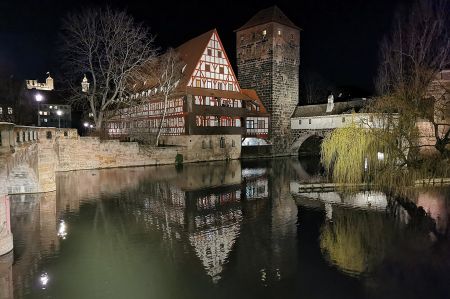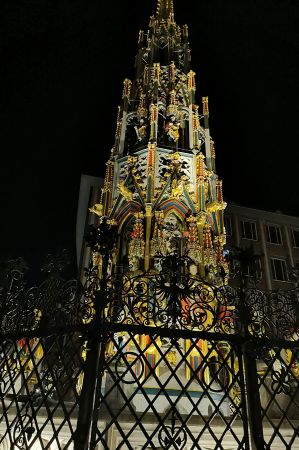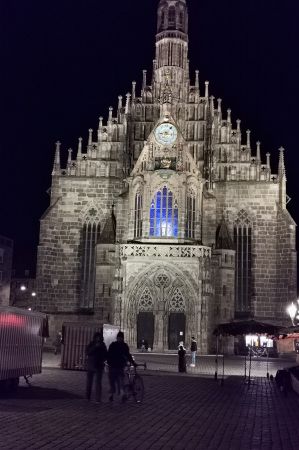Night tour through the old town of Nuremberg
- Written by Portal Editor
After a strenuous day at the Nuremberg Camping Fair, we were still so fit that we wanted to use the evening hours for a short tour of Nuremberg's old town.
That's how we started and this is also to be understood as a tip for your city tour, our tour of one of the three most important old town churches in Nuremberg, the Lorenzkirche (on the map No. 7). The church welcomes its visitors with a magnificent portal, inside you will find important works of art by Veit Stoss (angel greeting) or Adam Kraft as well as one of the largest organs in the world. Via the Kaiserstraße and the Karlsbrücke, built in 1486, we continue to the flea market, a small Pegnitz island with lovingly restored ensembles of houses.
From the Henkersteg to the Albrecht Dürer House
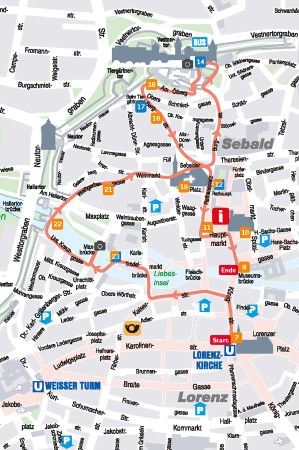 Before the heavy destruction in the Second World War and the very simplified reconstruction of the post-war period, the medieval old town of Nuremberg was considered one of the most important in Europe. However, some landmarks have been faithfully rebuilt, most notably the city's churches. In addition, some monuments have been preserved. The most important landmarks include some buildings along the historic mile, most notably Nuremberg Castle. In addition, other noble buildings and castles of the old HRR imperial city have been preserved.
Before the heavy destruction in the Second World War and the very simplified reconstruction of the post-war period, the medieval old town of Nuremberg was considered one of the most important in Europe. However, some landmarks have been faithfully rebuilt, most notably the city's churches. In addition, some monuments have been preserved. The most important landmarks include some buildings along the historic mile, most notably Nuremberg Castle. In addition, other noble buildings and castles of the old HRR imperial city have been preserved.
We cross the Henkersteg (No. 23), over which the hangman used to get to the city from his secluded apartment in the Henkerhaus (No. 23), then the path leads along the Pegnitz to the Maxbrücke.
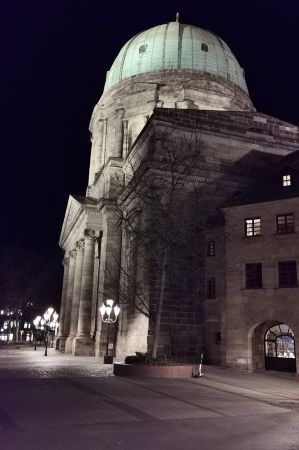 From here we have a wonderful view of the Weinstadel (No. 23) on one side and the Kettensteg (No. 22) on the other side, the next point on the walk. Alongside the Chain Bridge in Budapest, this is the oldest surviving iron chain bridge in continental Europe and leads directly to Weißgerbergasse (No. 21), whose around twenty historic houses are mostly made of half-timbered houses. Past the Sebalduskirche (No. 19), the oldest parish church in Nuremberg, the path now leads to the Old Town Hall (No. 12) with the medieval hole prisons (No. 12). Now it's uphill to the city's landmark: the Kaiserburg (No. 14). The walk is not only worthwhile because of the "Kaiser - Reich - Stadt" exhibition or the Kaiserburg Museum, but above all because of the fantastic view over the old town. Past the Sinwell Tower and along the Mount of Olives we reach the Albrecht Dürer House (No. 17), the former home and workplace of the famous artist.
From here we have a wonderful view of the Weinstadel (No. 23) on one side and the Kettensteg (No. 22) on the other side, the next point on the walk. Alongside the Chain Bridge in Budapest, this is the oldest surviving iron chain bridge in continental Europe and leads directly to Weißgerbergasse (No. 21), whose around twenty historic houses are mostly made of half-timbered houses. Past the Sebalduskirche (No. 19), the oldest parish church in Nuremberg, the path now leads to the Old Town Hall (No. 12) with the medieval hole prisons (No. 12). Now it's uphill to the city's landmark: the Kaiserburg (No. 14). The walk is not only worthwhile because of the "Kaiser - Reich - Stadt" exhibition or the Kaiserburg Museum, but above all because of the fantastic view over the old town. Past the Sinwell Tower and along the Mount of Olives we reach the Albrecht Dürer House (No. 17), the former home and workplace of the famous artist.
From the Tiergärtnertorplatz to the Heilig-Geist-Spital
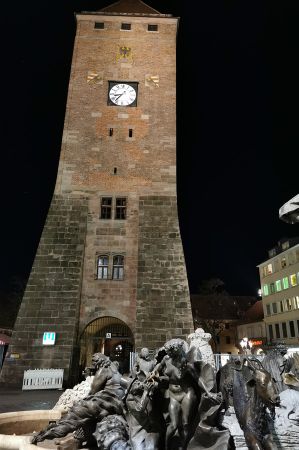 Here, at Tiergärtnertorplatz (No. 16), it is advisable to end the evening and "mix with the people". In summer this is a particularly popular hotspot among Nuremberg residents, but it was still too cold in mid-March. Bergstrasse takes you downhill (another tip: visit the historic rock passages (no. 18) and try a Nuremberg red beer) to the main market with the beautiful fountain (no. 11). Be sure to spin the Golden Ring and make a wish! On the opposite side of the market is the Frauenkirche (No. 10), on the west gable of which the "Männleinlaufen" takes place every day at 12 noon, a depiction of the seven electors passing Emperor Charles IV and the proclamation of the Golden Bull of 1356 remembered.
Here, at Tiergärtnertorplatz (No. 16), it is advisable to end the evening and "mix with the people". In summer this is a particularly popular hotspot among Nuremberg residents, but it was still too cold in mid-March. Bergstrasse takes you downhill (another tip: visit the historic rock passages (no. 18) and try a Nuremberg red beer) to the main market with the beautiful fountain (no. 11). Be sure to spin the Golden Ring and make a wish! On the opposite side of the market is the Frauenkirche (No. 10), on the west gable of which the "Männleinlaufen" takes place every day at 12 noon, a depiction of the seven electors passing Emperor Charles IV and the proclamation of the Golden Bull of 1356 remembered.
Various (cultural) events take place several times a year on the main market, the heart of the city, and the famous Nuremberg Christkindlesmarkt takes place during the Advent season.
Our first tour through the old town of Nuremberg also ends on the Museumsbrücke, with a view of the Heilig-Geist-Spital (No. 9).
Apropos: This is also the cradle of the famous Nuremberg bratwurst, which was once enjoyed by none other than Albrecht Dürer...
Due to an initiative of the radio station Energy Nuremberg, a path in Nuremberg's old town north of the new Bratwurst Museum up to the Henkersteg was renamed "Bratwurstgasse".
Nuremberg is one of the most important museum locations in the German-speaking world and has the most museums per inhabitant among the German cities with a population of over a million and half a million. In addition to the museums of the city of Nuremberg, there are a few other large museums run by state or private organizations, but there are also smaller museums that deal primarily with Nuremberg customs and history, or other specific subject areas.
Other special features of the metropolis of Nuremberg
In the Middle Ages, the Roman-German emperors did not rule from a city, but were constantly on the move to meet their vassals, hold court or attend imperial diets. When travelling, the emperor and his court were accommodated in imperial palaces along the travel routes. It is not without reason that the Imperial Castle in Nuremberg is one of the most important imperial palaces of the Middle Ages in Europe.
Please read as well:
Nuremberg - through the old town at night
Hike to Goseck Castle – starting point at the sun observatory
-
 Nuremberg - Hiking the old town at night
Nuremberg - Hiking the old town at night
Nuremberg - Hiking the old town at night
Nuremberg - Hiking the old town at night
-
 Nuremberg - Hiking the old town at night
Nuremberg - Hiking the old town at night
Nuremberg - Hiking the old town at night
Nuremberg - Hiking the old town at night
-
 Nuremberg - Hiking the old town at night
Nuremberg - Hiking the old town at night
Nuremberg - Hiking the old town at night
Nuremberg - Hiking the old town at night
-
 Nuremberg - Hiking the old town at night
Nuremberg - Hiking the old town at night
Nuremberg - Hiking the old town at night
Nuremberg - Hiking the old town at night
-
 Nuremberg - Hiking the old town at night
Nuremberg - Hiking the old town at night
Nuremberg - Hiking the old town at night
Nuremberg - Hiking the old town at night
-
 Nuremberg - Hiking the old town at night
Nuremberg - Hiking the old town at night
Nuremberg - Hiking the old town at night
Nuremberg - Hiking the old town at night
-
 Nuremberg - Hiking the old town at night
Nuremberg - Hiking the old town at night
Nuremberg - Hiking the old town at night
Nuremberg - Hiking the old town at night
-
 Nuremberg - Hiking the old town at night
Nuremberg - Hiking the old town at night
Nuremberg - Hiking the old town at night
Nuremberg - Hiking the old town at night
-
 Nuremberg - Hiking the old town at night
Nuremberg - Hiking the old town at night
Nuremberg - Hiking the old town at night
Nuremberg - Hiking the old town at night
-
 Nuremberg - Hiking the old town at night
Nuremberg - Hiking the old town at night
Nuremberg - Hiking the old town at night
Nuremberg - Hiking the old town at night
-
 Nuremberg - Hiking the old town at night
Nuremberg - Hiking the old town at night
Nuremberg - Hiking the old town at night
Nuremberg - Hiking the old town at night
-
 Nuremberg - Hiking the old town at night
Nuremberg - Hiking the old town at night
Nuremberg - Hiking the old town at night
Nuremberg - Hiking the old town at night
https://www.alaturka.info/en/germany/bavaria/5565-night-tour-through-the-old-town-of-nuremberg#sigProIdc6224fe9ee
